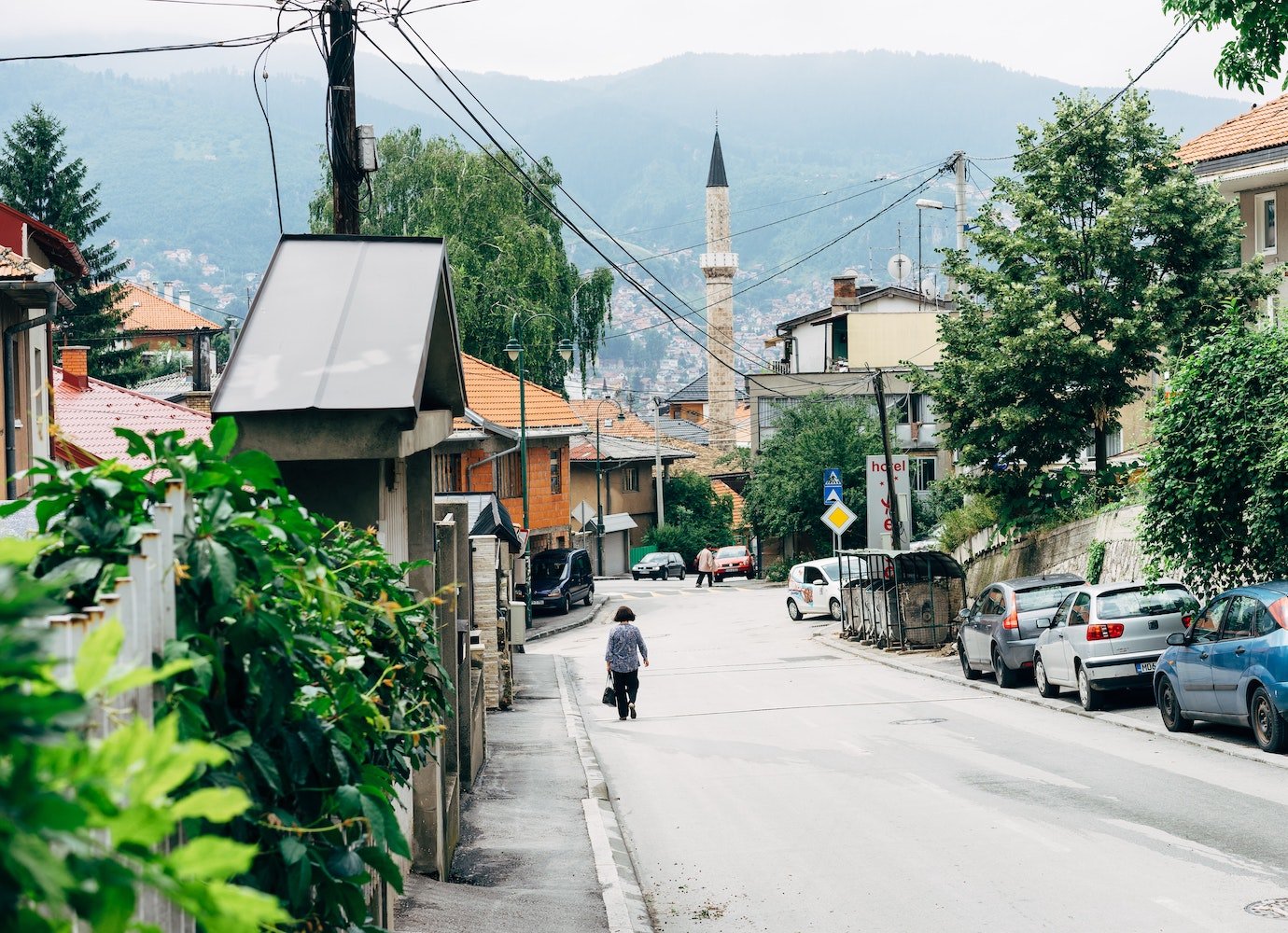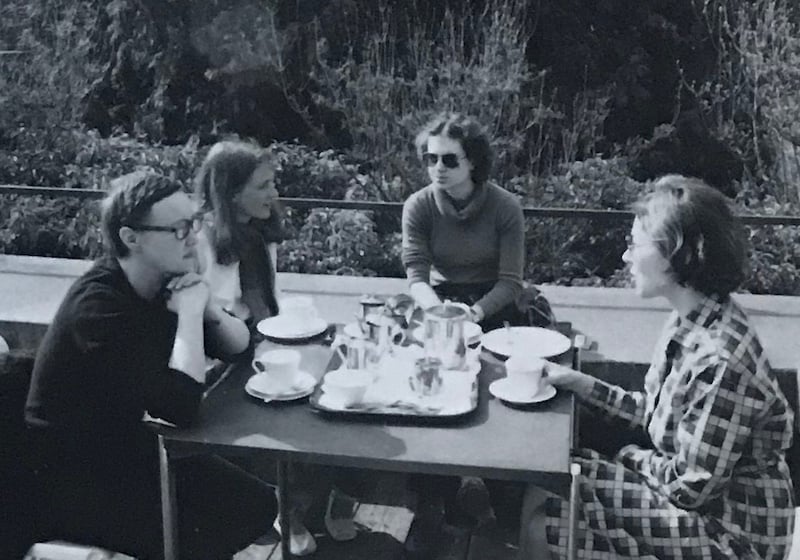‘We laughed until our laughter stopped’: the story of the sketch comedy group that predicted the end of Yugoslavia
Sketch group Top Lista Nadrealista crashed through socialist censorship to become Yugoslavia’s best-loved comedy stars. But for many, it's their seemingly-prophetic jokes mirroring the country’s ultimate fall that will remain their final legacy.
On 9 May 1981, six friends from Sarajevo got their big break on Bosnian radio. They promptly used their 15 minutes of fame to stage a fake terrorist takeover — using the airwaves to demand more young bands on the radio, the return of local youth centres, and the removal of older media executives. The chaotic segment was put together at a local kafana (bistro) just a few hours before broadcast, but it marked the birth of a Bosnian comedy institution: Top Lista Nadrealista (“The Surrealist Hit Parade”, or TLN). Their raw and rambunctious debut captured the comedy troupe’s rowdy, exuberant, and uncompromising spirit. Through their thinly-veiled language, they had slipped through the cracks of official censorship to criticise old Yugoslav politicians and call for the restoration of social infrastructure — all on state-controlled airwaves.
In Yugoslav jokes, Bosnians were often characterised as unsophisticated. TLN played on this in their sketches
TLN burst onto Yugoslavia’s cultural scene at the birth of a strange new era for the nation, just one year after the death of the country’s socialist leader since 1953, Josef Broz Tito. Starting on radio before making the jump to TV, TLN birthed a subculture that would skyrocket Sarajevo to Yugoslavia’s comedic epicentre. Made up of Nele Karajlić, Zenit Đozić, Zlatko Arslanagić, Elvis Kurtović, Boris Šiber, Dražen Ričl, Dado Džihan, and Branko Djurić among others, the troupe employed surrealism, satire, and dark humour to present the poetry of Sarajevo’s street life, celebrating unconventional Bosnian characters across Yugoslavia.
Sarajevo has always been a melting pot of cultures, a collision of the Ottoman and Austro-Hungarian empires, Yugoslav socialism, and Western cultural influence. TLN, from the vibrant neighbourhood of Koševo, used their surroundings as a fertile canvas for their comedic creations. In Yugoslav jokes, Bosnians were often characterised as unsophisticated. TLN played on this in their sketches, demythologising local people and in turn, inverting the gaze of others. All of TLN’s core members were from mixed ethnic heritages (the norm in pre-war Sarajevo), enabling them to explore various themes surrounding their own ambiguity. One sketch from 1989 shows Branko Djurić employing a “nationalism detector” that beeps in front of a line of men characterised as Albanian, Serbian, Croatian, Slovenian, Bosniac, and Montenegrin. When another man joins the group, the beeping gets louder. The group finds the source of the beeping to be his Yugoslav ID card, a playful recognition of intersecting identities that both united and divided the nation.
Actors appear in a televised TLN episode.
TLN’s work was part of a new movement, New Primitivism, which appeared in Bosnia in March 1983. Standing in direct opposition to the New Wave in Zagreb and Belgrade, which the New Primitives condemned as too concerned with Western pop culture, New Primitivism intended to platform the local. According to Kurtovič, a core TLN member, the group hoped to show that “the best camaraderie” was “at parties where the tables are full of burek and booze.” Laid out in a fanzine in 1982, their manifesto lauded “the new primitive man” as one “who reads challenging works such as Hegel, but doesn’t mind getting into fistfights.” Their embrace of the local was neither anti-intellectual, nor anti-Balkan, but a celebration of both. For them, authenticity was what it meant to be truly primitive.
By 1984, TLN had secured a 45-minute spot on Erna Perić’s prime time show for TVSa2, a Bosnian channel aired across Yugoslavia, where they churned out sketches that parodied TV stations, security doorman, football, and even Star Trek (the TLN version, Burek U Svemiru, was an attempt to locate the universe’s best burek). Music segments were integral to the series, paralleled by the rising fame of bands such as Zabranjeno Pusenje and Elvis and the Meteors. TLN member Nele Karajlić characterised this early run as “the result of our youthful hysteria, relying more on raw energy than brains’‘. Their raucous style of comedy and play on old Yugoslav stereotypes was the first of its kind on state-controlled airwaves. The groundbreaking series soon catapulted TLN and its members to fame across Yugoslavia. By 1984, the word mahalas (a Turkish term for neighbourhood in Sarajevan slang) and Hrkljuš, a fictional game created on the show, had reached the mainstream. TLN’s clothing, with pointy špicoke shoes, was the latest fashion trend. Bosnian humour formed a bedrock of Yugoslavian culture and Sarajevo was, for a time, its centre.
But by their second television season, five years later in 1989, TLN had become increasingly political. Their social commentary became more overt, shifting away from the nonsensical youthfulness that characterised the first season. Many of their sketches were eerily prophetic of the Yugoslav Wars which followed three years later, as the socialist state collapsed and the country began to fracture across ethnic lines. At the time, these new sketches were a direct result of brewing tensions and economic instability, which TLN faced with an unapologetic directness. “They told us of a future we couldn’t yet understand,” says Aco Vujinović, a fan from Mostar who watched TLN at the time.
TLN depicted families split into fanatical warring factions and trivial cultural differences escalating into violence; all tongue-in-cheek humour when first aired. In their shows, the troupe parodied a Bosnia made up of thousands of tiny countries, a divided Sarajevo, and even the presence of the United Nations, who were rejected from TLN’s fictional battlefield as “fake peacekeepers”. One sketch showed a man who only spoke “Herzegovinian” taking a Serbian-speaking woman on a date. The pair communicated through an interpreter, who would repeat the exact words verbatim (as the two languages were identical.) “At the time we laughed because we didn’t think this could ever happen to us,” Vujinović says. “We laughed until our laughter stopped, and everything that once seemed impossible became our reality”. TLN’s status as fortune-tellers was cemented with a sketch from 1989, which saw Karajlić declare that a divided Yugoslavia would come into existence on 12 November 1995. The Dayton Agreement that had ended the Bosnian War and formally divided Bosnia and Herzegovina along ethnic lines was signed on 14 December 1995.
When the Bosnian War broke out in 1992, TLN continued to broadcast surrealism from Sarajevo, even as the city was trapped under siege for almost four years. Whilst some core TLN members fled as refugees, those who remained refused to become demoralised. Undeterred by sniper fire, front line combat, and endless food and energy shortages, TLN put out more than 50 radio segments and four TV episodes between 1991 and 1993. Aired on Bosnia and Herzegovina’s only station as its single comedy show, the group would greet their audience: “Good evening, all three of you out there who still have batteries.” No one was above their mockery, and every side of the war was criticised. One televised sketch depicted Serbs arresting Czech tourists after mistaking them for Muslim extremists. In another, a chetnik child is healed of his “spirit” by a Bosnian “Super Imam”. Aid workers were depicted as vampires, luring innocent Sarajevans with false promises of feta cheese only to be met with forced blood donation. TLN even styled their own game based on the continuous risk of sniper fire. TLN member Zenit Đozić explained in a 2013 documentary by Al-Jazeera: “I don’t belong to any perspective. Which I think is my duty as a comedian and as an artist, to be independent.” By ridiculing the madness that surrounded them, TLN became a voice of reason amid warring parties.
No one was above their mocking. TLN even styled their own game based on the continuous risk of sniper fire
Ultimately, TLN’s humour became a connection back to a shared, lost culture. “There is a saying: smijeh je lijek; humour is medicine,” Vujinović says. “TLN continued that tradition, while war raged around them. Their humour became their remedy.” Or, as Kontić told The New York Times in 1993: “We know they listen to us in Belgrade, Zagreb, and the Serbian-occupied territories. Our refugees hear us all over Europe.” TLN’s members embodied a collective past, their ethnically-mixed heritage reflecting a once-peaceful existence. This engagement with humour and creativity, despite the violence, became an act of resistance. In the same New York Times article, Sasha Petrović, one of TLN’s members, emphasised: “you have to find humour to be able to function during months of depression like those we’ve suffered here. Without this, we’d all end up in an asylum.”
Norwegian troops deployed for the UN travel through Sarajevo in 1995. Image: Paalso/Wikimedia Commons under a CC licence
Yet ultimately, TLN’s fractious break up was one that spoke of the scars created during wartime. Many members of the troupe parted ways either during the war or soon after, leaving Sarajevo for good. Most famously, Nele Karajlic, who had been at the core of the series (as well as a frontman for the band Zabranjeno Pusenje), relocated to Belgrade during the war. With the help of celebrated director Emir Kusturica, he formed his own faction of the band Zabranjeno Pusenje.
Today, many of TLN’s members have continued their individual artistic endeavours and achieved new accolades, notably Branko Đurić, who starred in the Oscar-winning film No Man’s Land. TLN spin-off shows were recorded in 2007, 2012, and 2017, with a few core members. Yet, they never reached the same acclaim as the original. Many fans continue their love of the show through grainy YouTube clips, reflecting on its prophetic understanding of Yugoslavia’s demise. Vujinović explains to us “they are to us such a cult classic, a heritage I have proudly passed down to my children.” No English translation exists, nor can it be purchased on mainstream services — perhaps because of its untranslatable humour, in-jokes and culturally specific art form.
Ultimately, the work of TLN is an ode to surrealism: the spirit of irreverence and absurdity, making sense of a world that no longer makes sense. And while many will analyse their prophetic gifts — how the troupe was able to capture so much of their time, seemingly before their time - perhaps the most important thing is to look back on TLN’s sketches with the same humour with which they were created. As Kurtović himself suggested in a 2013 column on academic interest in TLN: “my immediate reaction is to fuck with them. Nothing gives me more satisfaction than seeing 30-year-old crap I wrote purely out of spite, indolence, or malevolence, now translated into English and dissected by serious people for deeper meaning.” We hope, Kurtović, we have made you proud.


